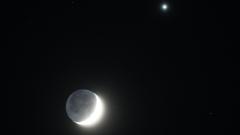Often referred to as the Evening Star or Morning Star due to its brightness, Venus has become a fixture of the night sky, guiding observers with its radiant glow. Looking ahead, January 2025 promises even more astronomical phenomena, with a rare sighting of both Venus and Saturn expected on January 18, where they'll be only 2.2° apart — an event that shouldn’t be missed.
In conjunction with this, the ongoing Quadrantid meteor shower, which began on December 26 and is set to peak on Saturday, beautifully complements the evening’s skyward views. It will be active until January 12, providing an excellent opportunity to witness shooting stars darting through the night sky.
Dr. Robert Massey, deputy director of the Royal Astronomical Society in the UK, encourages observers to escape light pollution for the best chances of viewing. He affirms that, given clear skies, the celestial display is a splendid New Year’s treat that should not be overlooked.
As images surface of the Moon and Venus illuminating various cityscapes — from Kolkata, India, to York and Edinburgh in England — excitement builds among celestial enthusiasts for what some are calling the perfect post-holiday astronomical celebration.
In conjunction with this, the ongoing Quadrantid meteor shower, which began on December 26 and is set to peak on Saturday, beautifully complements the evening’s skyward views. It will be active until January 12, providing an excellent opportunity to witness shooting stars darting through the night sky.
Dr. Robert Massey, deputy director of the Royal Astronomical Society in the UK, encourages observers to escape light pollution for the best chances of viewing. He affirms that, given clear skies, the celestial display is a splendid New Year’s treat that should not be overlooked.
As images surface of the Moon and Venus illuminating various cityscapes — from Kolkata, India, to York and Edinburgh in England — excitement builds among celestial enthusiasts for what some are calling the perfect post-holiday astronomical celebration.


















